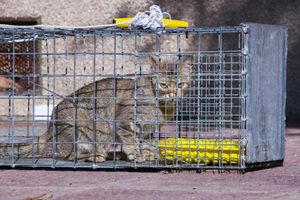The goal is to safely catch and return them to their owners.
You’ve seen them in the park near your house, darting across a busy road or running from bush to bush seeking cover from curious kids. It’s a stray dog or cat who you think might be lost or could have been abandoned. Whatever the cause, the animal appears to be in danger and you want to help.
Recognize if They Are Stray or Feral

©mariesacha/Adobe Stock
There are many ways to help stray animals without getting in too deep. First, though, you need to be able to differentiate between a stray and a feral animal.
- Stray animals are those who have been separated from an owner for whatever reason. They are accustomed to living with people. A scared stray cat or dog can be misjudged as feral if he is displaying fear and/or defensive aggression.
- Feral animals are those who those who have never lived with people. Feral cats will never approach a human or let a human approach them. Most feral dogs are unlikely to let you touch or come near them.
One of the easiest ways to determine if a cat is a stray and not feral is by using food. A completely feral cat will never take food directly from a human. In comparison, feral dogs might approach if you have food. Feral cats can never be domesticated; feral dogs sometimes can be.
The best way to help feral cats is to let them live peacefully in their territory. If you’re having an issue with their behavior, contact your local animal control and ask for their recommended list of TNR (trap-neuter-release) groups. They will let you know if anyone in the area is feeding or caring for them. The best way to help feral dogs is to contact your local animal control or a stay/feral dog rescue group.
Don’t Create a Bigger Problem

©czamfir/Adobe Stock
If you’re trying to help an animal who appears to be injured or you want to help them get out of traffic, you need to use common sense. Pull over to the side of the road, turn on the hazard lights and call authorities. If you have flares, you might need to use them. Solicit help from passersby. Don’t attempt to block traffic on your own while you move an injured animal from the road. Don’t try to chase the animal.
If you find yourself in a position of helping stray animals regularly, be prepared. Keep the following items in your vehicle:
- Disposable bowls you can leave behind.
- Spare leash and collar
- Towel or blanket to cover seats
- First aid kit
- Water
- Food and treats (canned tuna or a smelly fish-based food works well for cats, beef jerky or some form of chew treat can help with dogs)
- Carrier (this may be a cat carrier or cardboard box)
Capture the Animal

@happy monkey/Adobe Stock
The most important thing you can do is stay calm and relay a sense of peace to the animal. You might need to just wait quietly in a location where the animal can hear you while you wait for backup.
- Sit quietly: Don’t attempt to chase an injured animal. They might bolt back onto the roadway or panic and cause themselves or others serious harm.
- Lure them in: Food and water can go a long ways toward earning the trust of a frightened animal.
- Call for Help: If the animal is clearly frightened and defensive, the best thing you can do is wait for help. Keep your favorite 24-hour rescue on speed dial, along with local authorities and local rescue organizations.
- Live Traps: If you need to use a live trap to capture an animal, it’s best to do this in coordination with an animal rescue group or animal control.
Transport to Safety

©Monkey Business/Adobe Stock
If the animal is injured, the first thing to do is get them assistance.
- Your Veterinarian: If you take them to your veterinarian, be prepared to assume financial responsibility. While veterinarians are not equipped to assist on every rescue, if you have a good relationship with yours and can either pay the bill or raise the money to cover it, most will assist. At the very least, most vets will do their best to make sure any seriously injured animal is stabilized or humanely euthanized.
- Animal Control or Shelter: You might need to take an animal to your local animal control or shelter, which might charge an intake fee. This is to help prevent irresponsible owners from relinquishing unwanted animals and to offset the costs of keeping them.
If the animal is not injured, the only option you might have is to take them home. Some things to consider:
- If you have pets of your own, keep the new addition in a secure, isolated environment. You don’t want to expose your pets to any disease or parasites, nor do you want to stress out either party. Ensure they are safe, content, have food and water available (as well as a place to urinate).
- Prepare to keep the animal for a few days. You might not find the owners right away or the owners could be desperately searching for their pet. In either case, it could take a day or two to locate and arrange a transfer, so be sure you have enough supplies.
Locate the Owners
Once the stray animal has been safely secured, follow these steps:
- Check tags: If they are wearing a collar with tags, the first thing to do is call the owners. Keep in mind not everyone will answer an anonymous caller so be sure to also leave a voicemail and follow up with a text.
- Scan for a microchip: Take the animal to your local veterinarian and ask for a chip scan. I’ve never seen a veterinarian ever charge for this. If yours does, find a new veterinarian.
- Create posters: It’s simple to create a found dog or found cat poster.
- Check social media: There are thousands of Facebook groups devoted to lost and found pets. Check your local groups. These are usually named something like: “Lost dogs of STATE”, “Lost cats + AREA”, “found dogs + neighborhood”, “name of neighborhood + pets”, etc. The best social media platforms for finding the owners of found pets include: Facebook, Next Door (especially valuable in neighborhoods), Reddit and even Twitter. Post in as many groups as possible to increase likelihood of finding the owners and don’t forget to post on your personal pages.
- Create an ad on Craigslist or in a local newspaper: Most local newspapers and online media will not charge for lost or found pet ads.
Before turning an animal over to their owner, ask them to provide proof of ownership. This could include:
- License/registration of the animal that matches the chip information.
- Photos of the animal you’ve found with that particular owner.
- Owner correctly identifies specific markings and age/sex of animal.
- Animal responds positively to the person upon meeting.
If there is ever a question about returning an animal, contact the authorities and let them sort out the details.
About the Author: Stacy Mantle is a fulltime freelance writer, bestselling author and founder of PetsWeekly.com. She resides in the deserts of the Southwest with a few dogs, several cats and a very understanding husband.





